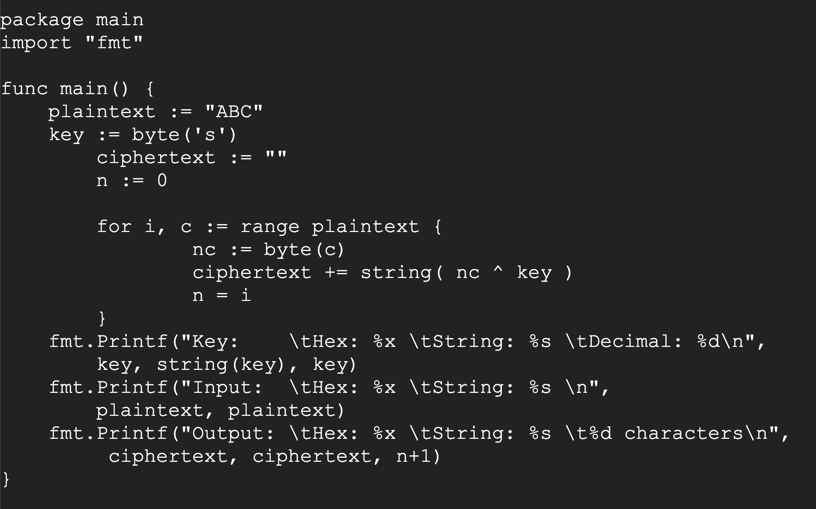
XOR operates on one bit at a time, with these results:
0 XOR 0 = 0
0 XOR 1 = 1
1 XOR 0 = 1
1 XOR 1 = 0
Characters are ASCII-encoded, like this:
A is 01000001
B is 01000010
C is 01000011
...
Consider A^B:
A is 01000001
B is 01000010
A^B= 00000011
However, A^s is printable:
A is 01000001
s is 01110011
A^B= 00110010
mkdir -p work/src/my_project/xor1
nano ~/work/src/my_project/xor1/xor1.go
package main
import "fmt"
func main() {
plaintext := "ABC"
key := byte('s')
ciphertext := ""
n := 0
for i, c := range plaintext {
nc := byte(c)
ciphertext += string( nc ^ key )
n = i
}
fmt.Printf("Key: \tHex: %x \tString: %s \tDecimal: %d\n",
key, string(key), key)
fmt.Printf("Input: \tHex: %x \tString: %s \n",
plaintext, plaintext)
fmt.Printf("Output: \tHex: %x \tString: %s \t%d characters\n",
ciphertext, ciphertext, n+1)
}

Save the file with Ctrl+X, Y, Enter.
Execute these commands to compile the program and run it:
go install my_project/xor1
xor1

On your Linux server, in a Terminal window, execute these commands:
mkdir -p work/src/my_project/xor2
nano ~/work/src/my_project/xor2/xor2.go
package main
import "fmt"
func main() {
plaintext := "210"
key := byte('s')
ciphertext := ""
n := 0
for i, c := range plaintext {
nc := byte(c)
ciphertext += string( nc ^ key )
n = i
}
fmt.Printf("Key: \tHex: %x \tString: %s \tDecimal: %d\n",
key, string(key), key)
fmt.Printf("Input: \tHex: %x \tString: %s \n",
plaintext, plaintext)
fmt.Printf("Output: \tHex: %x \tString: %s \t%d characters\n",
ciphertext, ciphertext, n+1)
}
Execute these commands to compile the program and run it:
go install my_project/xor2
xor2

232835272d2831312433With a key of a
Hint: to put raw hex into a string, use \x characters like this:
ciphertext = "\x41\x42\x43\x44"
150b070a0a190d031f1516070503The key is a capital letter, from A to Z.
6e6d04101e0208The key is a byte, between 0 and 255.
wget https://bowneconsultingcontent.com/pub/Attack/proj/A55.4_infile
wget https://bowneconsultingcontent.com/pub/Attack/proj/A55.5_infile
This is an image file. When decrypted, it starts with a PNG file header, as shown below:

Notice that the first 4 bytes are 89, 50, 4E, 47; the 2nd through 4th byte spell out PNG in ASCII.
Decrypt the file. When you get it, change its filename extension to PNG and open it in an image viewer or Web browser.
The flag is visible in the image.
During encryption, 16 bytes of plaintext are processed at a time, XORed with the 16 bytes of key.
To get the ciphertext, execute this command:
wget https://bowneconsultingcontent.com/pub/Attack/proj/A55.6_infile
Decrypt the file. When you get it, change its filename extension to PNG and open it in an image viewer or Web browser.
The flag is visible in the image.
To get the ciphertext, execute this command:
wget https://bowneconsultingcontent.com/pub/Attack/proj/A55.7_infile
JPG Signature Format: Documentation & Recovery Example
Decrypt the file. When you get it, change its filename extension to JPG and open it in an image viewer or Web browser.
The flag is visible in the image.